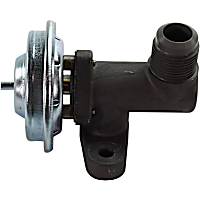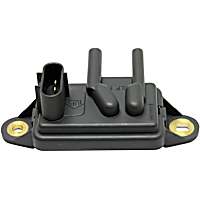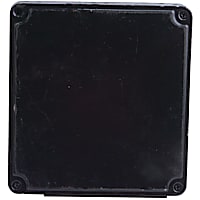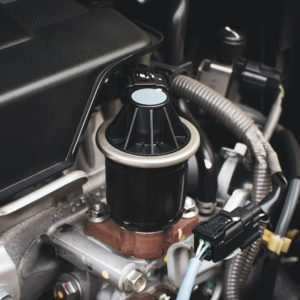OBD-II codes are standardized codes that point toward issues that could increase tailpipe emissions in vehicles, making it easier to diagnose and troubleshoot problems. If your OBD-II scanner registered a code P0400, that indicates a potential problem with your vehicle’s exhaust gas recirculation (EGR) system. Learn how to address it by learning about its meaning, causes, symptoms, and more.
What Does the P0400 Code Mean?
Diagnostic trouble code (DTC) P0400 code stands for “Exhaust Gas Recirculation (EGR) Flow Malfunction.” It is triggered when the flow of exhaust gas recirculation is lower than what the powertrain control module (PCM) expects.
The heart of the EGR system is the EGR valve, which redirects a portion of the exhaust gas into the engine intake manifold to be integrated into the air/fuel mixture. This reduces cylinder temperature and the amount of nitrogen oxide (NOx). If it malfunctions, your car may fail an emission test.

In modern vehicles, the EGR valve is controlled by the PCM. Meanwhile, on older vehicles, the valve is usually controlled directly by the engine vacuum.
If the PCM detects that there is insufficient exhaust gas being sent into the engine, code P0400 will be triggered. This means that the system is not recirculating exhaust gas under conditions that require EGR.
An in-depth knowledge of the EGR system can help you come up with a proper DIY fix for P0400. Otherwise, if you’re not planning to troubleshoot the code yourself, you can continue reading about the possible causes of this code.
What are the Possible Causes of the P0400 Code?
The causes of the P0400 code may differ depending on the make and model of your car. Here are the most common causes of an EGR flow malfunction or code P0400:
- Faulty EGR valve
- Clogged EGR passage
- Disconnected or damaged vacuum lines
- Faulty EGR-related sensor (e.g., EGR temperature sensor, EGR pressure sensor, etc.)
- Issues with the EGR control circuit, such as damaged wires or poor connections
- An issue with the PCM, such as software in need of an update


What are the Common Symptoms of the P0400 Code?
Now that you know what causes the P0400 code, it’s time to learn how to identify it. You may encounter issues that concern the driveability of your car if code P0400 is triggered. Here are the common symptoms of this DTC:
- Illuminated check engine light
- Engine hesitation
- Difficulty in starting the engine
- Rough idling
- Reduce power or poor acceleration
- Engine knocking or detonation
- Reduced fuel economy
In some cases, the vehicle will exhibit no symptoms other than an illuminated check engine light or malfunction indicator lamp (MIL).
How to Diagnose the P0400 Code
Many issues can trigger the P0400 code, which can make it difficult to identify its exact cause. Leave this task to an expert if you are not well-versed in automotive repairs. Otherwise, you may diagnose the problem yourself. Watch these helpful videos to learn more about the P0400 code and get an idea of what its diagnostic process might involve:
How to Fix the P0400 Code
To fix the P0400 code, you must identify and resolve its exact cause. You also need to make sure that the solution you implement is applicable to your vehicle’s make and model. If you are uncertain of your automotive know-how and DIY skills, letting your trusted mechanic handle the job may be your best option. Otherwise, begin the repair process.
Pinpoint what triggered the P0400 code. With the help of online auto repair resources and guides, determine the most effective way to resolve the issue. Get an ALLDATA single-vehicle subscription for comprehensive factory repair information that will definitely prove helpful in fixing not only the P0400 code but also any other future issue you may encounter.
Finally, keep in mind that the repair instructions for the P0400 code may vary based on the vehicle’s make and model.
Need New EGR Valves to Fix a P0400 Code?
The EGR valve redirects exhaust gases back into the engine to lessen emissions. When this part malfunctions, the P0400 code can trigger and cause your vehicle to fail an emissions test. You shouldn’t let this issue persist. You’ll likely need to get this issue fixed down the road in order to pass an emissions test. Good thing getting a replacement EGR valve is easy here at CarParts.com.
Replacing broken engine components can be costly. Good thing you don’t have to pay exorbitant prices at the dealership since CarParts.com offers EGR valves at competitive prices. You can trust our parts because they’ve passed stringent quality control standards during manufacturing. Our user-friendly website also makes shopping for replacement parts easy, so you can order the part you need with just a few clicks.
Our available EGR valves are ready to ship, so we can deliver your part straight to your doorstep in as fast as two business days! Shop for an EGR valve at CarParts.com now.
Products Mentioned in this Guide
Any information provided on this Website is for informational purposes only and is not intended to replace consultation with a professional mechanic. The accuracy and timeliness of the information may change from the time of publication.


 EGR Valve
EGR Valve
 EGR Pressure Feedback Sensor
EGR Pressure Feedback Sensor
 Engine Control Module
Engine Control Module
















